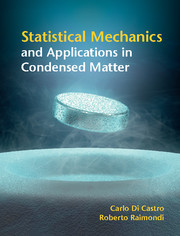Description
Statistical Mechanics and Applications in Condensed Matter
Authors: Di Castro Carlo, Raimondi Roberto
An innovative and modular textbook combining established classical topics in statistical mechanics with the latest developments in condensed matter physics.
Language: English
Subject for Statistical Mechanics and Applications in Condensed Matter:
Approximative price 80.97 €
In Print (Delivery period: 14 days).
Add to cart
Publication date: 08-2015
544 p. · 19.7x25.3 cm · Hardback
544 p. · 19.7x25.3 cm · Hardback
Description
/li>Contents
/li>Biography
/li>
This innovative and modular textbook combines classical topics in thermodynamics, statistical mechanics and many-body theory with the latest developments in condensed matter physics research. Written by internationally renowned experts and logically structured to cater for undergraduate and postgraduate students and researchers, it covers the underlying theoretical principles and includes numerous problems and worked examples to put this knowledge into practice. Three main streams provide a framework for the book; beginning with thermodynamics and classical statistical mechanics, including mean field approximation, fluctuations and the renormalization group approach to critical phenomena. The authors then examine quantum statistical mechanics, covering key topics such as normal Fermi and Luttinger liquids, superfluidity and superconductivity. Finally, they explore classical and quantum kinetics, Anderson localization and quantum interference, and disordered Fermi liquids. Unique in providing a bridge between thermodynamics and advanced topics in condensed matter, this textbook is an invaluable resource to all students of physics.
Preface; 1. Thermodynamics: a brief overview; 2. Kinetics; 3. From Boltzmann to Gibbs; 4. More ensembles; 5. The thermodynamic limit and its thermodynamic stability; 6. Density matrix and quantum statistical mechanics; 7. The quantum gases; 8. Mean-field theories and critical phenomena; 9. Second quantization and Hartree–Fock approximation; 10. Linear response and fluctuation-dissipation theorem in quantum systems: equilibrium and small deviations; 11. Brownian motion and transport in disordered systems; 12. Fermi liquids; 13. The Landau theory of the second order phase transitions; 14. The Landau-Wilson model for critical phenomena; 15. Superfluidity and superconductivity; 16. The scaling theory; 17. The renormalization group approach; 18. Thermal Green functions; 19. The microscopic foundations of Fermi liquids; 20. The Luttinger liquid; 21. Quantum interference effects in disordered electron systems; Appendix A. The central limit theorem; Appendix B. Some useful properties of the Euler Gamma function; Appendix C. Proof of the second theorem of Yang and Lee; Appendix D. The most probable distribution for the quantum gases; Appendix E. Fermi–Dirac and Bose–Einstein integrals; Appendix F. The Fermi gas in a uniform magnetic field: Landau diamagnetism; Appendix G. Ising and gas-lattice models; Appendix H. Sum over discrete Matsubara frequencies; Appendix I. Hydrodynamics of the two-fluid model of superfluidity; Appendix J. The Cooper problem in the theory of superconductivity; Appendix K. Superconductive fluctuations phenomena; Appendix L. Diagrammatic aspects of the exact solution of the Tomonaga Luttinger model; Appendix M. Details on the theory of the disordered Fermi liquid; References; Author index; Index.
Carlo Di Castro is a member of the 'Accademia Nazionale dei Lincei' and Emeritus Professor of Theoretical Physics at the Sapienza University of Rome, where he has been at the forefront of teaching and research in statistical mechanics and many-body theory for over forty years. His current interests include strongly correlated electron systems, quantum criticality, high temperature superconductivity and non-Fermi-liquid metals.
Roberto Raimondi is Associate Professor of Condensed Matter Physics at Roma Tre University where he has made important contributions to the understanding of the transport properties of disordered and mesoscopic systems. His current research interests include spintronics, especially the spin Hall effect and topological insulators.
Roberto Raimondi is Associate Professor of Condensed Matter Physics at Roma Tre University where he has made important contributions to the understanding of the transport properties of disordered and mesoscopic systems. His current research interests include spintronics, especially the spin Hall effect and topological insulators.
© 2024 LAVOISIER S.A.S.
These books may interest you

Essential Statistical Physics 40.64 €



